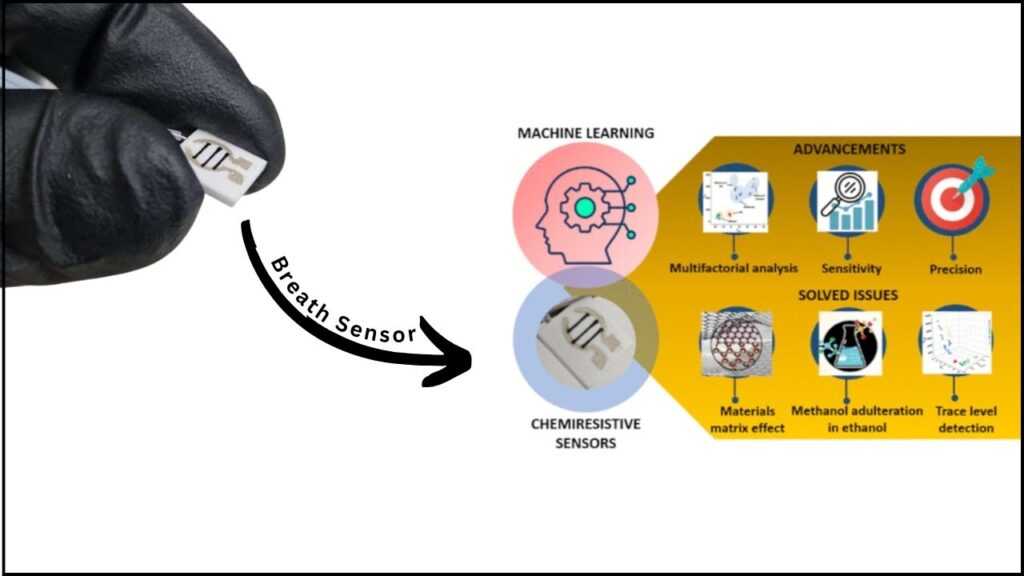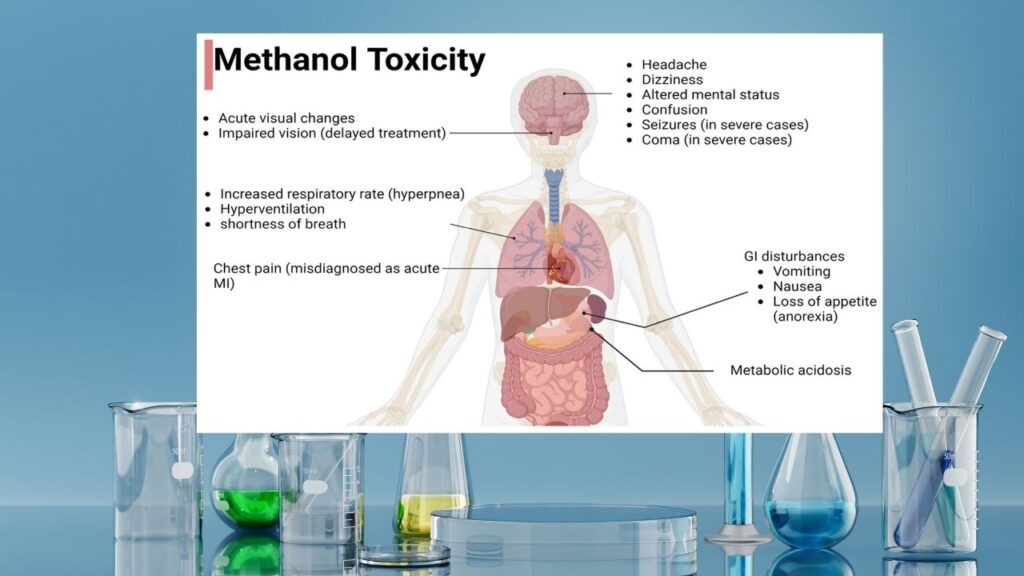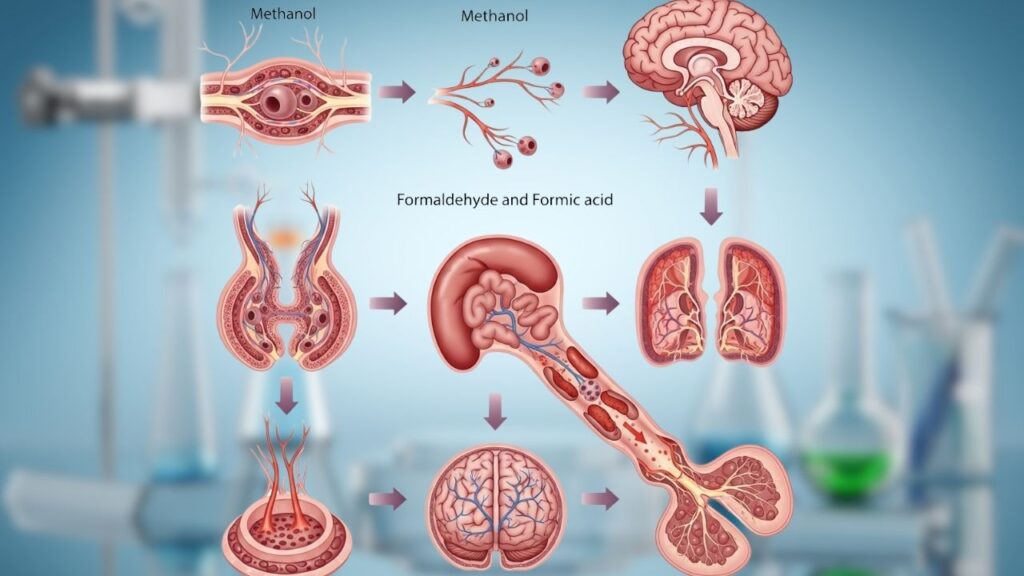New Breath Sensor Detects Methanol Poisoning: Methanol poisoning remains a persistent and deadly threat worldwide, especially in regions where illicit or adulterated alcohol is consumed. In 2025, a new breath sensor has emerged as a breakthrough, offering a fast, reliable, and non-invasive way to detect methanol poisoning directly from a person’s breath.

This innovation promises to transform emergency care, public health responses, and even routine safety checks in communities at risk.
New Breath Sensor Detects Methanol Poisoning
| Feature/Fact | Details |
|---|---|
| Sensor Technology | Graphene and metal-organic frameworks (MOFs) for ultra-sensitive detection |
| Detection Limit | As low as 50 parts per billion (ppb) of methanol in breath |
| Speed | Results in about 2 minutes |
| Accuracy | Comparable to benchtop mass spectrometry (R² = 0.966) |
| Practical Use | Portable, handheld, and usable by first responders |
| Professional Impact | Enables rapid screening, guides treatment, supports public health |
| Official Resource | ACS Sensors Journal |
The new breath sensor for methanol poisoning marks a transformative leap in public health and emergency medicine. By harnessing the power of graphene, MOFs, and smart algorithms, this device delivers rapid, accurate, and life-saving results from a simple breath test. Its portability, sensitivity, and ease of use make it a vital tool for first responders, hospitals, and communities facing the ongoing threat of methanol poisoning. As this technology becomes more widely available, it promises to reduce the toll of methanol-related deaths and disabilities, especially in vulnerable regions.
Understanding Methanol Poisoning
What Is Methanol and Why Is It Dangerous?
Methanol (also called wood alcohol) is a clear, colorless liquid used in many industrial and household products. Unlike ethanol—the alcohol found in beer, wine, and spirits—methanol is extremely toxic to humans. Even small amounts can cause severe health problems, including:

- Blindness
- Seizures
- Organ failure
- Death
Methanol is sometimes illegally added to alcoholic beverages to increase profit, especially in low-income regions. According to the World Health Organization, methanol poisoning outbreaks can cause hundreds of deaths and many cases of permanent disability each year, particularly in developing countries and during times of alcohol scarcity.
How Does Methanol Poisoning Occur?
Methanol poisoning typically results from drinking adulterated or homemade alcohol. It can also occur through accidental inhalation or skin contact in workplaces using methanol-containing products. Once in the body, methanol is converted to formaldehyde and formic acid, both of which are highly toxic and can damage nerves, organs, and the brain.

Symptoms and Urgency
Early symptoms of methanol poisoning can be mild—headache, nausea, dizziness—but can quickly progress to severe metabolic acidosis, vision loss, confusion, and coma. Without rapid treatment, the consequences are often fatal or permanently disabling.
Traditional Diagnosis: The Challenges
Diagnosing methanol poisoning has always been challenging:
- Blood Tests: The gold standard is a laboratory blood test, but this requires specialized equipment, trained staff, and can take hours or days to deliver results.
- Resource Limitations: Many regions hit hardest by methanol poisoning lack the infrastructure for rapid lab-based diagnostics.
- Clinical Confusion: Methanol and ethanol intoxication can look similar, making it hard for doctors to quickly distinguish between the two.
The New Breath Sensor: How It Works
The Science Behind the Sensor
The new methanol breathalyzer is a marvel of modern materials science and engineering:
- Advanced Materials: The sensor uses a conductive ink made from graphene and zirconium-based metal-organic frameworks (MOFs). Graphene is an ultra-thin, highly conductive material, while MOFs act like molecular sieves, trapping specific molecules such as methanol.
- Chemiresistive Sensing: When a person breathes onto the sensor, methanol molecules interact with the surface, changing the sensor’s electrical resistance. This change is detected and analyzed in real time.
- Separation Column: To ensure methanol is detected even in the presence of much higher ethanol concentrations, some sensor designs include a separation column (often Tenax TA) that physically separates methanol from ethanol before detection.
- Machine Learning: Advanced algorithms help the sensor distinguish methanol from other volatile compounds, ensuring accuracy even in complex breath samples.
Step-by-Step: Using the Sensor
- Breath Collection: The patient breathes into the handheld device.
- Molecule Separation: The device’s internal column separates methanol from ethanol and other substances.
- Detection: The sensor “sniffs” the breath, measuring methanol concentration.
- Analysis: Machine learning algorithms process the data, providing a clear result.
- Results: Within about 2 minutes, the device displays methanol levels and can wirelessly transmit results to a smartphone or medical database.
Example: Real-World Impact
During a festival in a rural area, several people fall ill after consuming local alcohol. With the new breathalyzer, health workers quickly screen each patient. Those with high methanol levels are prioritized for urgent treatment, while others receive standard care for ethanol intoxication. This rapid triage can mean the difference between life and death.
Why This Sensor Is a Game-Changer
Speed and Simplicity
- Traditional blood tests can take hours or longer; the new sensor delivers results in just 2 minutes.
- Non-invasive: No needles, no waiting—just a simple breath test.
Sensitivity and Accuracy
- Detects methanol at parts-per-billion (ppb) levels, far below concentrations found in poisoned patients.
- Validated against laboratory mass spectrometry, with a high correlation (R² = 0.966).
- Can reliably distinguish methanol from ethanol, even when ethanol is present at up to 62,000 ppm—hundreds of times higher than methanol.
Portability and Accessibility
- Handheld and battery-operated, making it ideal for use in ambulances, clinics, or remote locations.
- Wireless connectivity allows instant data sharing with medical teams or public health authorities.
Professional and Public Health Impact
- First responders can rapidly screen patients, distinguishing methanol poisoning from regular alcohol intoxication.
- Hospitals can monitor treatment progress in real time, adjusting care as methanol levels drop.
- Public health officials can deploy the device during outbreaks to quickly identify contaminated alcohol sources and prevent further cases.
Practical Advice: What to Do in Case of Suspected Methanol Poisoning
- Seek Immediate Medical Help: Methanol poisoning is a medical emergency. Call emergency services or go to the nearest hospital.
- Do NOT Wait for Symptoms: Early symptoms can be mild, but severe effects can develop quickly.
- Use the Breath Sensor (if available): If you have access to the new breathalyzer, use it to check for methanol exposure.
- Inform Medical Staff: Share any test results and details about what was consumed.
- Do NOT Try Home Remedies: Only trained professionals can treat methanol poisoning, often with antidotes and dialysis.
The Science and Validation: What Makes This Sensor Reliable?
Peer-Reviewed Research
The sensor’s development and validation have been published in respected scientific journals. Key findings include:
- Detection Range: The sensor can measure methanol in breath from 1 to 1,000 ppm, covering the full range seen in poisoning cases.
- Stability: The sensor remains stable over weeks of repeated use, with minimal drift and no significant degradation.
- Selectivity: The combination of a separation column and advanced sensor materials ensures that methanol is detected accurately, even in complex mixtures like human breath or contaminated beverages.
- Field Testing: The device has been tested on volunteers with spiked breath samples, showing excellent agreement with gold-standard mass spectrometry.
Regulatory and Safety Considerations
While the technology is still being rolled out, its performance in controlled studies suggests it meets high standards for diagnostic accuracy and reliability. As with any new medical device, further validation in larger clinical trials is ongoing to ensure safety and effectiveness in diverse settings.
Meta Launches New AGI Lab to Dominate the Future of Artificial Intelligence
Scientists Uncover Bumblebee Colony’s Secret Pause Strategy That Changes Everything
Fugaku Remains the World’s Graph King — Still #1 in Global Supercomputing Rankings
FAQs About New Breath Sensor Detects Methanol Poisoning
What makes methanol so dangerous?
Methanol is broken down in the body into formaldehyde and formic acid, which are highly toxic and can cause blindness, organ failure, or death, even in small amounts.
How is methanol poisoning treated?
Doctors use antidotes like fomepizole or ethanol to block methanol’s toxic effects and may use dialysis to remove methanol from the blood.
Can regular breathalyzers detect methanol?
No. Standard breathalyzers only measure ethanol and cannot distinguish methanol, which is why the new sensor is so important.
Who can use the new breath sensor?
The device is designed for use by healthcare workers, first responders, and trained community health volunteers.
Is the sensor available worldwide?
The technology is being introduced in pilot programs and research partnerships, with the goal of expanding access to high-risk regions.
Where can I learn more or get the device?
Official research journals and public health announcements provide updates as the technology becomes more widely available.
The Future: Beyond Methanol
The underlying technology—combining separation columns, advanced sensor materials, and machine learning—holds promise for detecting other toxins and diseases from breath, such as acetone for diabetes monitoring or volatile organic compounds for cancer screening. As sensor technology advances, we can expect even more portable, affordable, and accurate diagnostic tools to revolutionize healthcare worldwide.






